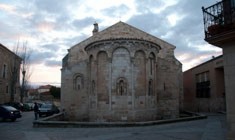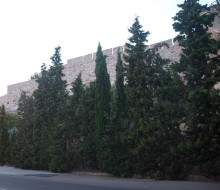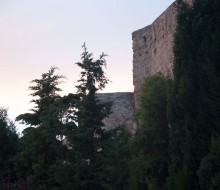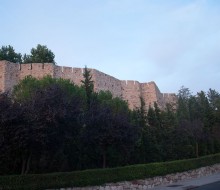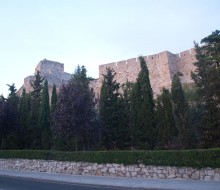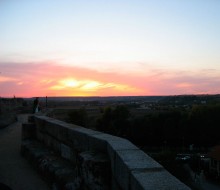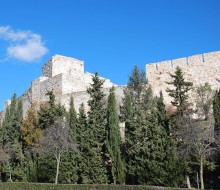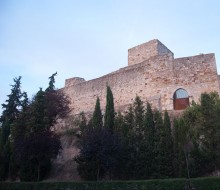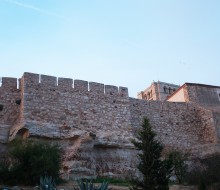Walled enclosures
Zamora
Walled enclosures
Zamora11th-13th centuries
Zamora always held the title of “La bien cercada” (what means The well-enclosed) and still remains some of the three walled enclosures that defended the city during the 11th, 12th and 13th centuries.
From the Arab invasion, it was an important strategic and defensive point together with Porto, Toro and Simancas. Because of the advance of the frontier to the Tagus, the city changed this function, and its new rearguard location caused a Romanesque explosion.
The walls were built in three successive phases which resulted in three areas. The first one dates from the 11th century, the second from the 12th century and from the 13th century the third.
First walled enclosure
It was built during kings Ferdinand I and Alfonso VI times.
Opposite this walled enclosure, it took place the episode called “El Cerco de Zamora”. Its design fits to the rocky escarpment over which the city rises. The following gates remains:
- Gate of Olivares or Optimal gate. It is located between the house of the Cid and the Episcopal Palace.
- Gate of Santa Colomba is included in the castle. This gateway served as drainage.
- Portillo de la Traición (what means Betrayal Wicket-Gate). Bellido Dolfos entered through it after killing the king Don Sancho II in 1072.
- Doña Urraca’s Gate, is the best preserved of all. It is located next to the palace that belonged to the Lady of Zamora, Doña Urraca.
- Right beside the previous gate, there is the Portillo de la Reina (what means Queen Wicket-Gate), through which you can gain access to the palace.
There were other gates, such as Santa Leocadia and San Cipriano but only a few remains have been preserved. One of the round turrentes and the starting point of the entrance arch can be seen at the Mercadillo gate.
Second Walled Enclosure
Its origin lies in the burgs and villages that were outside the city walls and needed to be protected. It was built in the 12th century during the reign of Ferdinand II and Alphonse IX (1157-1230) which both were born in the province of Zamora, linking this one to the first walled enclosure and increasing the city area.
It has been the most altered and the one that has suffered more damages of all due to it was located in an expansion area of the city. During the 18th century were carried out improvements such as the construction of the small fort of “San Sebastian” (St. Sebastian) and the reinforcement of some corners and gates. The remains of the Gate of San Andrés (St. Andrew), are also called the "Castiello de Sant Andrés".
Third Walled Enclosure
Its construction took place around the year 1325 during the reign of Alphonse XI. There is a large wall called "Degolladero-Puerta Nueva" which starts at the second enclosure and continues along the river until it joins to the Romanesque bridge, which was originally fortified by two towers. It continues along the bank to the "Puerta del Pescado" (that means fish’s gate). This gate does not exist nowadays and enclosed the so-called "Puebla del Valle".
It is visible the arch support of the so-called gate "Puerta Nueva" and a walled-up small gate in the disappeared Cavalry-Barracks wing, near the Romanesque bridge. The missing part of the walls was demolished during the late-19th and mid-20th centuries under the guise of modernity and sanitation.
GET DIRECTIONS
ROUTES
OPENING HOURS AND VISITS
Free entrace
GENERAL INTEREST SERVICES
Tourist offices:
- Local tourist office: It is located at 5, Arias Gonzalo Square. Tel. +34 980 533 694
- Castilla y León tourist office: It is located at 1, Príncipe de Asturias Avenue. Tel. +34 980 531 845
- Provincial tourist office: It is located at Viriato Square. Tel. +34 980 534 047
Local police: Tel. +34 980 531 245
Civil Guard (police with responsibilities outside towns): Tel. +34 980 521 100
Emergency telephone numbers: 112
- Virgen de la Concha (Hospital): Tel. +34 980 548 212
Bus station: Tel. +34 980 521 281
Train station: Tel. +34 980 521 110
Taxi: Tel. +34 630 630 630
Civil defence: Tel. +34 980 536 190
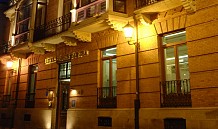
Hotel Horus
Zamora
El Hotel Horus, abierto en el año 2001, tiene un total de treinta y ocho habitaciones dobles que se dividen entre cuatro…
More info